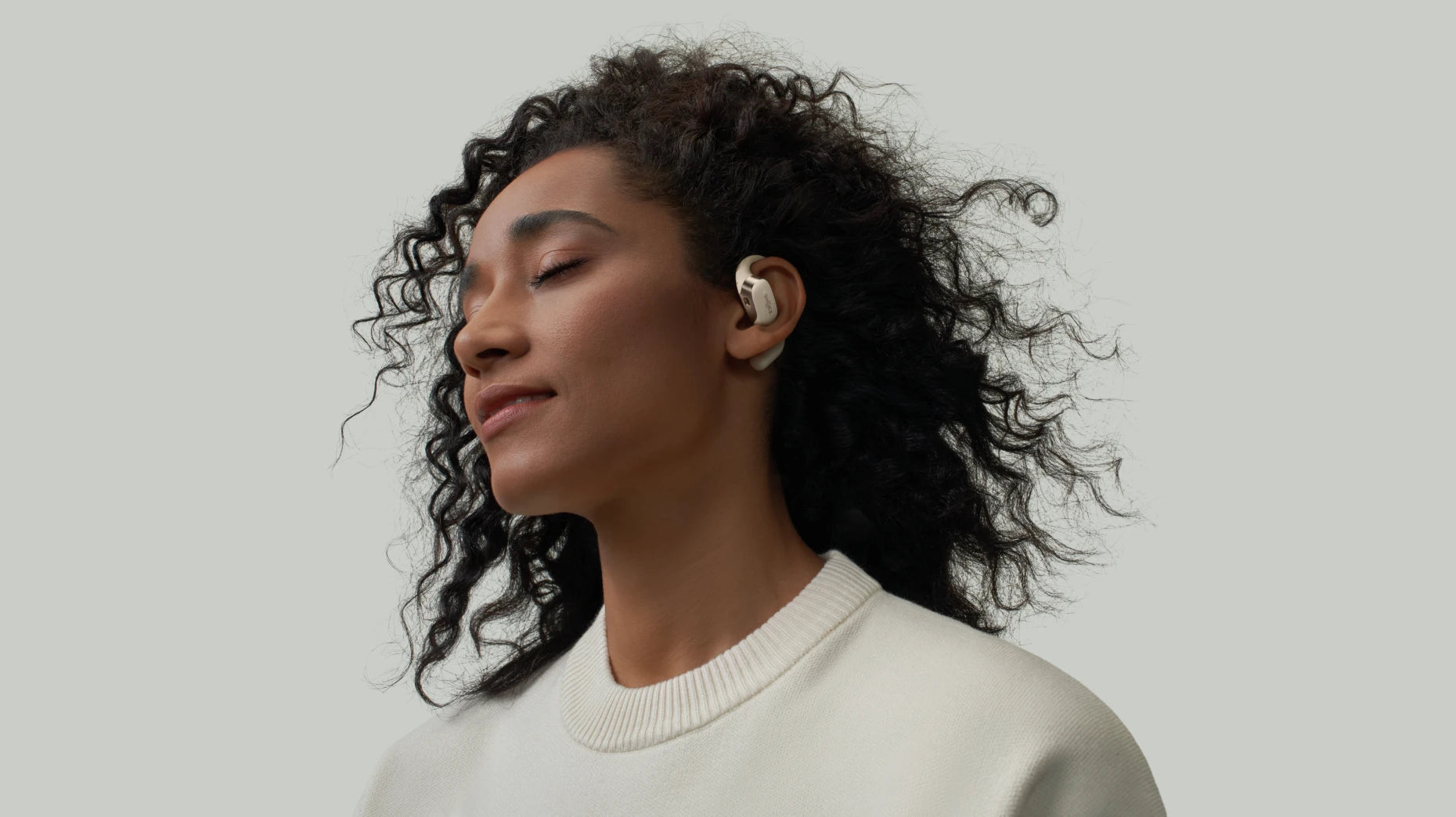Earbuds That Don't Go in Your Ear: Open Earbuds
Do you find in-ear headphones uncomfortable, especially during extended listening sessions, or do they constantly slip during your runs or workouts? Maybe it’s time to try a pair of open-ear headphones. But what are they? And how do they work? In this article, we’ll discuss the ins and outs of open-ear headphones and how to choose the best pair for you.
What Are Earbuds That Don't Go in Your Ear?
Earbuds that don't go in your ear are open-ear headphones that rest outside your ear canal, keeping you aware of your surroundings while delivering clear sound. Open-ear headphones use technologies like bone conduction and directed air conduction to transmit sound through vibrations. This design leaves your ear canal unobstructed, allowing you to stay open to your environment and still hear your audio clearly.
Different Types of Open-Ear Designs
Feature/Category
|
Bone Conduction
|
Air Conduction
|
|
How It Works
|
Transmits sound vibrations through the bones of the skull, directly to the inner ear, bypassing the eardrum.
|
Transmits sound waves through the air into the ear canal, where they vibrate the eardrum.
|
|
Form Factors
|
Behind-ear hooks, wrap-around headbands, clip-ons
|
In-ear, on-ear, over-ear, open-ear
|
|
Common Use Cases
|
Sports, commuting, work-from-home
|
Office, commuting, gaming/media
|
|
Popular Brands
|
Shokz, Mojawa, H20 Audio
|
Sony, Bose, Shokz
|
How Do Outside Ear Headphones Work?
Bone Conduction Technology
Bone conduction technology essentially uses a person’s bones instead of their ear canal as a sound pathway to the inner ear. The process is simple. Sound waves are picked up by a microphone, converted into mechanical vibrations via a transducer, and then transmitted through the bone tissue of the skull, specifically the temporal bone, until the vibrations reach the cochlea in the inner ear.
This spiral-shaped bone cavity converts sound vibrations into electrochemical signals that are then sent to the brain via the auditory nerve. Once the signals reach the brain, they are interpreted and processed as sound in the auditory cortex.
Air Conduction or Airflow Design
Air conduction technology functions by way of sound propagating through the air. In the case of open-ear headphones, the speakers rest outside the ear canal and direct sound waves through it until they reach the eardrum, which converts and amplifies the waves into vibrations.
Those vibrations then pass through three tiny bones, known as ossicles, until they reach the cochlea. From there, the path is just like that of bone-conducted sound: the cochlea sends electrochemical signals through the auditory nerve to the temporal lobe of the brain for processing.
What Are the Benefits of Headphones That Don't Go in Your Ear?
Comfort for All-Day Wear
Most open-ear headphones utilize an ear-hook design, gently resting behind the ears to provide a more secure, lightweight fit than in-ear headphones, which often fall out during intense activity. They also eliminate pressure on the ear canal during prolonged listening sessions and allow for better air circulation throughout the day, preventing the buildup of heat and moisture, which can cause irritation.
Situational Awareness and Safety
One of the main benefits of the open-ear design is it allows you to maintain situational awareness since the ear canal remains unobstructed. This provides for greater safety when cycling or running on busy streets. It also allows you to enjoy your audio in an office environment while still remaining aware of your surroundings, whether that’s an important announcement or a coworker looking to ask you a quick question.
Compatibility with Glasses and Helmets
Because open-ear headphones sit in front of the ear or just outside the ear canal, they usually don’t overlap with the arms of your glasses, so there isn’t any pinching or discomfort. And with their flexible, lightweight designs, you can easily adjust them around your glasses if necessary. In terms of helmets, the wrap-around headbands can keep them stable under a helmet, even during movement, while their slim profile ensures that there isn’t any pinching or discomfort.
How to Choose the Right Open-Ear Headphones for You?
Consider Sound Quality and Technology Type
Sound clarity and power are crucial factors when choosing the right open-ear headphones. You should consider things like frequency response and sound leakage, and whether there’s any distortion. For bone conduction headphones, make sure there aren’t excessive vibrations that can lead to discomfort. Between bone conduction and air conduction headphones, the former often struggle to produce deep, rich bass compared to the latter. This is because the higher density of bone requires more energy to transmit low-frequency vibrations.
Fit and Comfort
From its weight to its materials and design structure, there are different components that can affect how comfortable a pair of open-ear headphones are. You want them to be light but also stable, so that they don’t move around while you’re exercising. Most brands use an over-ear design and plastic material. Shokz, however, uses an ergonomic and flexible ear-hook design to ensure a soft and secure fit.
Battery Life and Connectivity
Having to charge constantly can be frustrating, especially if you’re enjoying the outdoors and far from any outlets. A great pair of open-ear headphones will not only have Bluetooth and a long-lasting battery life, but they’ll also have quick-charge capabilities that can give you a nice boost when you’re in a pinch.
The Best Open-Earbuds: Shokz OpenDots ONE on Your Way
Intro: OpenDots ONE is the smallest, lighter pair of earbuds from Shokz, as well as the first pair of clip-on earbuds. This minimalist design makes them sleeker and cozier than most earbuds on the market. They’re also fully open-ear, allowing you to maintain situational awareness while listening to your music

Price: $199.95
5 Main Features of OpenDots ONE Open Ear Headphones
1. All-New Form: OpenDots ONE offers stability through its U-shaped design, which clamps onto the helix of the outer ear. This gives you the compactness of in-ear earbuds with all the benefits of the open earbuds.
2. Wearing Experience: Combining a nickel-titanium plate with a soft silicone grip, OpenDots ONE provides a snug, ultra-comfortable fit.
3. Sound Quality: Thanks to Bassphere Technology, OpenDots ONE delivers punchy, low-frequency sound while minimizing sound leakage. It’s also equipped with Dolby Audio, which brings out the most subtle sound details so you can immerse yourself in a richer audio experience.
4. User-Friendly Craftsmanship: OpenDots ONE offers long battery life, fast-charging capabilities, and the convenience of wireless charging. They’re also interchangeable, both in your ears and in the charging case.
5. IP54 Water Resistant: From sweat to a drizzle of rain, OpenDots ONE can handle the elements so you can keep the music going.
Check more about how to Shop OpenDots ONE
Q1: Are open-ear headphones healthier?
A1: Yes, open-ear headphones reduce the risk of damaging the eardrum and don’t put any pressure on the ear canal. They’re also more hygienic than in-ear headphones, which allow earwax to accumulate within the ear canal and even foster bacterial growth, due to moisture, warmth, and lack of air circulation. This can lead to infection.
Q2: Are open-ear headphones good for working out or running?
A2: Yes, open-ear headphones are ideal for running and working out because their ear-hook design keeps them stable during exercise and their openness provides greater safety by allowing you to stay aware of your surroundings.
Conclusion
Open-ear headphones use bone conduction and air conduction technology to transmit audio while keeping your ear canal unobstructed. They provide safety through greater situational awareness and all-day comfort by eliminating pressure on the ear canal. Their lightweight, sleek designs are also very compatible with glasses and helmets. If you’re looking for a new pair of open-ear headphones, look no further than the OpenDots ONE. Visit the Shokz website today to learn more.



![What Are Open Ear Headphones? [Full Guide]](http://shokz.com/cdn/shop/articles/what-makes-open-ear-headphones-unique-shokz-united-states_552x.png?v=1765182319)



